I figure I’d share some tips for the novice fisher-person, basic Bass Fishing 101, hence the title. In Part 1 I’ll share just the basic information concerning the different styles and rigging techniques and in Part 2 I will go into more detail concerning them.
First off let’s start with the knots I like to use. Along time ago as I was watching a popular fishing show the host did a scientific test on which knot was the best by using a machine that measured break strength of some knots. Consistently the Palomar knot out performed all others. The line never broke at the knot so this told me that the knot did not weaken the line at all. The biggest trick was to wet the line before pulling it tight to reduce abrasion.
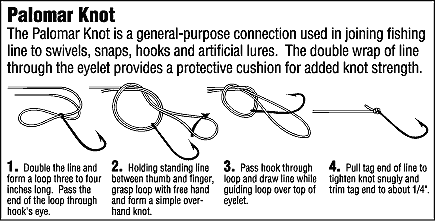
Since that day the Palomar knot is the knot I use about 90% of the time. It’s very easy to tie, even in the dark. One tip, its easier to run the line through the hook eye, point side first then run it back through instead of attempting to push the line doubled up through the eye. This is the knot to use on a drop shot rig, just leave a long, 8-24 inch “Tag” end to attach the weight. I’ll cover the details a little later.
Another good knot is the Trilene knot, also known in some circles as a modified clinch knot This is the knot that my dad taught me when I was very young, he however just called “The Fishing Knot”
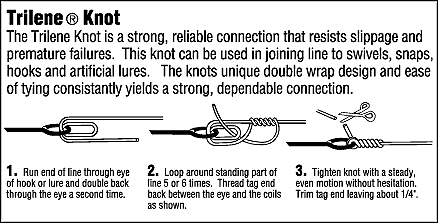
There are several other good knots one can use but the 2 I mentioned above are the ones I personally use. Quick, easy and efficient.
Line: There are a lot of good lines out there, I personally like fluorocarbon line for a lot of applications due to the fact that they are virtually invisible underwater allowing to to use a heavier line. Keep in mind that different applications call for different lines. My rule of thumb is to always use the lightest line you can get away with. About the only time that rule does not apply is when fishing top water lures. When fishing top water lures I use a prefer braided line because the line floats better and helps keep the nose of your lure up.
Now I’ll discuss some different terms of techniques as well as some information on each.
Plastics. Talk about a whole big can of worms. You’ve got worms, these come in a very wide range of sizes and styles. You’ve got little finesse type lures, reapers, gobies and allot of others. Next there are Lizards, Crawfish imitations, Creature Type baits, Senko type do nothing baits, Sluggo’s, Tubes…………….. I could go on and on, the list is so vast.
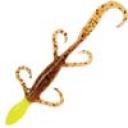
For fishing plastic’s you’ve got your several different styles of fishing. There is the Carolina Rig, Split Shot Rig, Texas Rig, Drop Shot Rig, Darter Head, Slider Head and Shakey Heads. Where terms like Dragging, Long Lining, Shaking, Doodling and Dead Sticking are used commonly
1. Carolina Rig:
This is a rig generally used to cover allot of water semi quickly. It consists of. A “Barrel” type weight, one that line can slide freely through, a swivel, a glass or plastic bead, a 12-48 leader and of course the hook.
There is no right size weight to use. You want to be able to get the bait down to the bottom and be able to stay in contact with your offering as well as the bottom. To rig it, insert the line from your rod into and through the weight. Place your glass or plastic bead on the line, the bead is mainly used to protect your knot from the sinker banging on it. It also provides sound, especially effective in off colored water. Tie your swivel on, then your leader, the length of the leader depends on how far you want your bait to be off the bottom. Tie on your hook, the size depends on the size of your lure. Finally, rig up your bait weedless.
2. Split Shot Rig: This rig is pretty much used the same as the Carolina rig only slower. Its just a modified finesse version of the Carolina rig on light line. The difference being, no swivel, no bead, no extra leader and you use a different weight. To rig this one simply tie on your hook and pinch a split shot, I prefer the round ones, a trick I learned from Dick Trask, because they go through structure easier, 8-24 inches up your line, of course don’t forget to add your lure, rigged weedless.
3. Texas Rig: This is one of the most common techniques for fishing plastic worms when the fish are feeding off the bottom. Get yourself a bullet style sinker and hook. Slide the sinker on your line with the “pointy” side facing upwards and tie your hook on. If you add a bead between the weight and hook you convert the basic Texas rig to a Doodling rig. You can also “Peg” the weight to keep it from sliding. This “pegging of the weight” technique is used when your fishing in weeds or sticks and you don’t want the weight and worm to separate.
4. Drop Shot Rig: This rig is effective when bass are feeding up off the bottom. To rig this one tie your hook on with the Palomer knot and leave a 6-18 inch tag end. After tying the knot on take the tag end and run it through the eye of the hook, point side up and pull it tight. What this does is causes your hook to stand out straight allowing your bait to sit level. I like to tie a snap swivel on then attach a “Bell Style” also known as a casting sinker, weight to the snap. This helps to avoid line twist. Then attach your bait to the nook. Either nose hook it with the hook exposed or rig it weedless, whichever way the situation dictates.
5. Darter, Slider and Shakey Heads: These techniques are deadly on suspended fish. All these rigs consist of are just a lead head on a hook. The way they are rigged is just insert the hook into the worm and in most cases you leave the hook exposed but rig it weedless if the situation dictates.
6. And of course the Ned Rig Which was actually pioneered by anglers such as Guido Hibdon, and Charlie Brewer but was brought to mainstream attention by Ned Kehde, from Lawrence, Kansas
As you can see the list goes on and on.
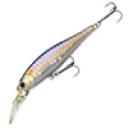
From plastics we now go to reaction baits. The name Reaction Baits cover a whole plethora of baits. They are basically any bait where your looking for a reaction type bite.
The bass sees it and then he reacts to, be it out of hunger, anger or just plain orneriness. Here you’ve got, Surface baits, Rip baits, Jerk baits, Crank baits, Spinner baits, Chatter baits, Buzz Baits and Swim baits, which I discussed earlier. As you can see the list is quite large and I’m sure I left quite a few off of my list. Terms like, Walk the Dog, Popping, Waking, Burning, Jerking, Twitching, Cranking, And Slow Rolling are common with these techniques.
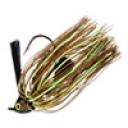 Then you’ve got jigs. These are one of my favorite techniques for catching quality bass. I will be dedicating a whole post to these in the future. Basically they are a lead head with a skirt and a trailer. They are generally thought to resemble a crayfish, which just in case you didn’t know, is a fresh water lobster. I don’t know about you but I sure have a tough time passing up lobster and the bass seem to share my weakness.
Then you’ve got jigs. These are one of my favorite techniques for catching quality bass. I will be dedicating a whole post to these in the future. Basically they are a lead head with a skirt and a trailer. They are generally thought to resemble a crayfish, which just in case you didn’t know, is a fresh water lobster. I don’t know about you but I sure have a tough time passing up lobster and the bass seem to share my weakness.
There are also drop style baits. In this category you have Spoons and Ice Jigs. The Drop Shot and Shakey Head techniques also fit into here. These techniques excel during the colder months but are also effective when the bass are suspending or sitting on structure to deep to get a crank bait down to.
Well readers, that should give you some information to absorb. Like I said, I’ll go into more details on these techniques in part 2.
Until Next Time, Good Luck and Tight Lines To Ya!

